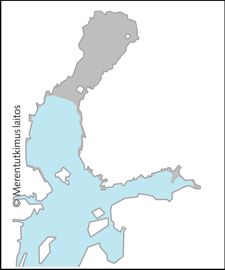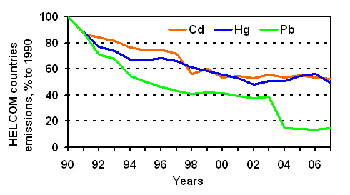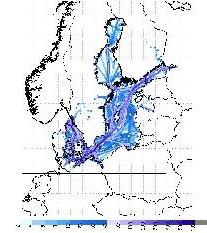HELCOM Indicator Fact Sheets for 2009
As the environmental focal point for the Baltic Sea, HELCOM, has been assessing the sources and inputs of nutrients and hazardous substances and their effects on ecosystems in the Baltic Sea for almost 30 years. The resulting indicators are based on scientific research carried out around the Baltic Sea under the HELCOM PLC, COMBINE and MORS monitoring programmes. During the past few years, HELCOM Indicator Fact Sheets have been compiled by responsible institutions around the Baltic and approved by the HELCOM Monitoring and Assessment Group for publication. The Indicator Fact Sheets for 2009 and 2008 are listed in the navigation menu on the left and older ones can be found in the Indicator Fact Sheet archive.Changing seasons
The monthly mean sea surface temperatures during 2008 were higher than the long term mean values except for the months August and September. This contributed to a further increase of the yearly mean temperature of the Baltic Sea. Particularly, the months February to May belonged to the warmest in the period 1990-2008. The maximum temperatures were observed on 31 July because a cooling started already on 1 August from the north. The ice season of 2007-2008 was very late, short and extremely mild in terms of ice extent. According the Russian Ice Service the ice season was the warmest during more than the 100-years period of observations. The largest ice cover – 49,000 km² – was reached as late as on the 24th of March and on the 25th May the Baltic Sea was ice free.
The wave climate in the Baltic Sea during 2008 was characterised with rather strong monthly and spatial variation. On average the roughest months were January, February, March, August and November, while April, May and December were calmer. Several monthly records were made in different parts of the Baltic Sea but on the yearly basis the significant wave heights remained under record values.
Life pulsates according to water inflows
The present state of the Baltic Sea is not only the result of anthropogenic pressures but is also influenced by meteorological conditions and hydrographic forces such as water exchange between the Baltic Sea and the North Sea. The inflow of waters from the Kattegat into the Baltic Sea during 2002-2003 terminated the stagnation period in the Baltic deep water which lasted since 1995. The period afterwards has been characterized by low inflow activities and except for in the southern Baltic, the stagnation period lasting since 2004/2005 is strengthening further. A baroclinic inflow in summer 2006, followed by small barotropic inflows in 2007 caused again very high temperatures observed in the central Baltic deepwater. Decreasing inflow activity in 2008 caused in 2009 a deterioration of the previously fair oxygen conditions in the Bornholm Basin.
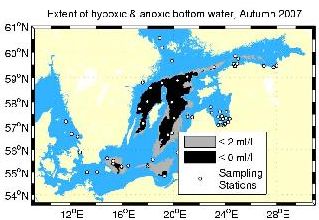 This stagnation period has resulted in a steady worsening of oxygen conditions in the deep basins of the Baltic Proper. In the South Eastern Baltic Proper, Western and Eastern Gotland Basins and Northern Baltic Proper, deep water salinity has increased, making the ventilation of these deep basins less likely.
This stagnation period has resulted in a steady worsening of oxygen conditions in the deep basins of the Baltic Proper. In the South Eastern Baltic Proper, Western and Eastern Gotland Basins and Northern Baltic Proper, deep water salinity has increased, making the ventilation of these deep basins less likely.
Meteorological conditions, including wind patterns and precipitation affect the inflow of water from the catchment area and the deposition of pollutants directly onto the sea. The total runoff to the Baltic Sea area shows no long-term trend for the period 1950 – 2008. On the other hand this time period is characterized by dry and wet periods lasting for a couple of years. In the last 11 years, the total inflow to the Baltic Sea has decreased from a top flow rate of over 17,500 m3/s in 1998 to less than 11,000 in 2003. In 2008, the flow of 14 473 m3/s is much higher and above the mean.
The Baltic Sea continues to suffer the impacts of human activities
Baltic Sea habitats and species are threatened by eutrophication and elevated amounts of hazardous substances as a result of decades of human activities in the sea and its surrounding catchment area.
The inputs of some hazardous substances to the Baltic Sea have reduced considerably over the past 20 to 30 years, in particular discharges of heavy metals. In 2006, the reported waterborne loads of mercury. lead and cadmium entering the Baltic Sea were 10.8 tonnes, 274 tonnes and 47.5 tonnes, respectively. During the period 1994-2006 riverine annual heavy metal loads (notably cadmium and lead) seem to have decreased for most of Contracting Parties.
Annual emissions of heavy metals to the air originating from HELCOM countries have decreased during the period 1990-2007 by 48% for cadmium, 51% for mercury, and 85% for lead. During the same period, the amount of cadmium, mercury and lead deposited on the Baltic Sea via the atmosphere has decreased by 46%, 23%, and 69% respectively.
Annual emissions of dioxins and furans have decreased in HELCOM countries during the period 1990-2007 by 21%. In 2007 the total annual PCDD/F emissions from HELCOM countries amounted to 1.4 kg TEQ with the largest contributions to the total annual PCDD/F emission coming from Russia (56%) followed by Poland (31%) and Germany (6%). In the same period, the annual atmospheric deposition fluxes of PCDD/Fs over the Baltic Sea have decreased by 62%. The most significant change in PCDD/F atmospheric deposition can be noted for the Gulf of Bothnia (68%) and the Baltic Proper (63%).
A range of anthropogenic activities contribute to the significant inputs of nutrient to the sea, which enter the sea via runoff, riverine input, through direct waterborne discharges or via atmospheric deposition. Although nutrient inputs from point sources such as industries and municipalities have been cut significantly, the total input of nitrogen to the Baltic Sea is still almost 837,500 tonnes per year, of which approximately 25% enters as atmospheric deposition on the Baltic Sea and 75% as waterborne inputs. The total input of phosphorus to the Baltic Sea in 2006 was ca 28,000 tonnes and entered the Baltic Sea mainly as waterborne input with the contribution of atmospheric deposition being only 1-5 % of the total. The main source of nutrient loads to the Baltic Sea is agriculture.
When comparing the 2006 waterborne nutrient loades to the 10 year average (1997-2006), waterborne nitrogen input load has decreased by about 5%, and phosphorus by almost 15%. The riverine, coastal and point source flow in 2006 was 11% lower than the 10-year flow average suggesting that a large part of the nitrogen and phosphorus reductions are due to hydrological variations. Total waterborne phosphorus inputs have clearly decreased suggesting positive effects of the implementation of load reduction measures in catchment area. It is known that the load reduction measures are particularly efficient for phosphorus in municipal wastewater treatment plants.
For most of the HELCOM countries, there was a decline in the annual emissions of nitrogen to the air during the period 1995 – 2007. The opposite trend can be noticed for ammonia emissions from Finland and Lithuania and nitrogen oxides emissions from Latvia and especially Russia. Emissions from outside the Baltic Sea region add to the airborne nitrogen loads entering the Baltic, as do emissions from shipping. In 2008, both NOx and SOx emissions from shipping peaked during the summer months but the overall trend for SOx is decreasing. The emissions of NOx seem to be leveling off after a strong increase in 2006-2007, probably due to the global financial crisis and the smaller volumes of cargo transported. The number of crude oil tankers, bulk cargo and general cargo ships decreased during 2008 when compared to the year 2007. In contrast, the number of small vessels increased significantly especially during summer months.
Mainly because of interannual changes in meteorological conditions, annual nitrogen depostion to the Baltic Sea and its sub-basins varies significantly from one year to another in the period 1995 - 2007. Nevertheless, the annual depositon of oxidized, reduced and total nitrogen in 2007 was respectively 14%, 2% and 8% lower than in 1995.
Eutrophication intensifies phytoplankton blooms
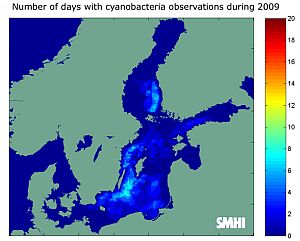 Eutrophication is the result of excessive nutrient inputs to the ecosystem and is an issue of major concern almost everywhere around the Baltic Sea area. The excess nutrients have resulted in an increased average biomass production by a factor of 2.5, leading to decreased water clarity, exceptionally intense algal blooms, more extensive areas of oxygen-depleted sea beds* as well as degraded habitats and changes in species abundance and distribution.*
Eutrophication is the result of excessive nutrient inputs to the ecosystem and is an issue of major concern almost everywhere around the Baltic Sea area. The excess nutrients have resulted in an increased average biomass production by a factor of 2.5, leading to decreased water clarity, exceptionally intense algal blooms, more extensive areas of oxygen-depleted sea beds* as well as degraded habitats and changes in species abundance and distribution.*
A decrease in water clarity has been observed in all Baltic Sea sub-regions over the last one hundred years, with it being most pronounced in the Northern Baltic Proper and the Gulf of Finland. An increase in water transparency during the last 20 years has been detected in the Bornholm and Arkona Seas and in Kattegat and the Eastern Gotland Basin the decreasing trend has ceased during the past 10 to 15 years with the water transparency remaining at about the same level.
In 2008, the concentrations of dissolved surface nutrients* near the surface increased until March-April in the Gulf of Finland and until February in the Northern Baltic Proper and the Bornholm Sea. This is considerably later than during the previous two years.
Dissolved inorganic nitrogen levels remain below the 1993 – 2002 average in the offshore Baltic. The spatial distribution of inorganic (primary bio-available) nutrients* (in surface waters, during winter) highlights problem areas, and shows the availability of nutrients for the spring bloom. Changes in the spatial distribution may indicate changes in the hydrography or the effect of remedial works.
The spring bloom was larger (phytoplankton biomas) than long term average in the Northern Baltic Proper, otherwise the chlorophyll-a levels followed close to the long term average.
Cyanobacterial blooms in the summer of 2009 were characterized by large variations both in time and space. This year's bloom was relatively harmless in comparison with previous years; the normalized bloom intensity and duration during 2009 were well below average (1997-2007), while the normalized extent of the bloom was normal.
The cyanobacteria bloom index* shows, that in 2007 the toxic Nodularia spumigena rank based abundance was highest ever recorded and twice as high as in the previous year, while Aphanizomenon flos-aquae showed slightly higher values in the year 1999.
The satellite-derived chlorophyll-like pigments* in the Baltic Sea are clearly higher than in the Skagerrak and North Sea. The chlorophyll a concentration* exceeded 3mg m-3 for more than 60% of the days during the summer period 2006 (June-September) in the Arkona, Bornholm, Easter Gotland and Northern Gotland Basins and Gulf of Riga and Finland.
Bacterioplankton growth rate is an indicator of the decomposition of organic matter, and thus indicates the rate of oxygen consumption that may lead to oxygen deficiency in the water column. Bacterioplankton accounts for half of the pelagic oxygen consumption.The bacterial growth in the Bothnian Bay and Bothnian Sea has been stable for the past 15 years, suggesting a balanced nutrient supply to and organic production in the two basins.
Annual sedimentation dynamics*** in the Central Baltic can be separated into three distinct periods which can be allocated to different drivers of pelagic biomass production. Winter surface accumulated nutrients* are used by spring bloom algae*, summer mixed layer biomass production is governed by nitrogen fixing cyanobacteria and increased water mass convection in autumn finds its response in an autumn bloom of a mixed algal community. All three surface production peaks are reflected in respective transport events of organic matter to the sediment. Annual integrated rates for sedimentation of organic matter*** in the Gotland Sea have not show significant trends between 1995 and 2003 although the major Baltic inflow event in January 2003 exerted a pronounced effect on both surface biomass production and mode of vertical particle transport resulting in an overall increase of organic carbon supply to the sediment by a factor of four.
Hazardous substances still persistent in the marine environment

The health status and reproductive ability of top predators such as grey seals and white-tailed sea eagle also reflect the state of the Baltic environment. Although the reproductive health investigated in grey seals has improved since the middle of 1980s and the population is increasing at about 8% a year since 1990, the prevalence of intestinal ulcers has increased significantly in investigated juveniles since the mid 1980s and the mean blubber thickness has decreased significantly in investigated by-caught juveniles during the past 10 years.
Strong relationships have been found between white-tailed sea eagle reproductive ability and concentrations of DDTs and PCBs in their eggs. Reproduction in the Baltic eagle population in the 1970s was reduced to a fifth of the pre-1950 population size. Following bans of DDT and PCB during the 1970s around the Baltic, eagle productivity began to recover in the 1980s and since the mid-1990s is largely back to a pre-1950 level. The population on the Swedish Baltic coast has increased at 7.8 % per year since 1990. Nevertheless, on the Swedish coast of the Bothnian Sea, nestling brood size remains below the pre-1950 level and the occurrence of dead eggs is significantly higher than in the Baltic Proper and Bothnian Bay, indicating a possible impact from other contaminants.
Concentrations of contaminants in fish vary according to substance, species and location. Although there is no consistant trend in mercury concentrations, the concentrations of lead and PCBs have decreased significantly as a result of measures taken to reduce discharges of of these contaminant to the environment. Recent levels of cadmium in herring are not significantly lower compared to the concentrations measured at the beginning of the 1980s, despite measures taken to reduce discharges of cadmium to the environment.
The concentrations of TCDD-equivalents (dioxins) in guillemot eggs show an overall significant decreasing trend, however, not during the recent 15 years. A significant increasing trend can be seen in the Bothnian Bay for TCDD-equivalents in herring muscle from 1990-2007. No significant changes can be found in Kattegatt and the southern Baltic Proper for the same time period, which coincides with the results for guillemot eggs during this time period. As for the concentrations of flame retardants HBCD, a significant increase of about 3% per year can be observed in Guillemot eggs while a decreasing trend can be seen for HBCD in herring muscle from Utlängan in the southern Baltic Proper during the monitored time period, 1999-2007. No significant trend in herring muscle can be found at the other monitored localities.
The levels of perfluorooctane sulfonate (PFOS)* in Guillemot eggs in the early 2000s have been found to be 25-30 times higher when compared to levels in the late 1960s. No trend can be observed during the last ten year, but, due to the long environmental half-live of PFOS it cannot be expected that levels will decrease rapidly.
Overall the levels of radioactivity in the Baltic Sea water and biota have shown declining trends since the Chernobyl accident in 1986, which caused significant fallout over the area. In general, the discharges of radionuclides from local nuclear power plants into the Baltic Sea have shown decreasing trends during the last decade and contribute less than 1% of total inputs of radioactivity into the Baltic Sea. Radioactivity is now slowly transported from the Baltic Sea to the North Sea via Kattegat. The amount of caesium-137 in Baltic Sea sediments however has remained largely unchanged, with highest concentrations in the Bothnian Sea and the Gulf of Finland.
Impacts of shipping on the marine environment
An increase in the number of maritime transportation during the past decade has increased the potential for an increased numbers of illegal oil discharges. Furthermore, emissions of nitrogen oxides from shipping contribute to the eutrophication of Baltic Sea.
Ecosystem effects
The biodiversity of the Baltic Sea is affected by a wide range of anthropogenic as well as natural pressures. Variables such as climate-induced changes in temperature and salinity, fishing pressure, as well as variations in bottom water oxygen conditions (climate and eutrophication induced) all have significant impacts on ecosystem structure*.
As phytoplankton is an important component of the ecosystem, changes in phytoplankton events* represent changes in the ecosystem. During winter and spring 2007–2008 an unusual increase in a haptophyte belonging to the genus Chrysochromulina was observed in several parts of the Baltic Sea. Although the reasons for the exceptional and prolonged development of this species are still unknown, monitoring data show that temperature, salinity and PO4 were higher and DIN lower than average. A very similar, not identified, species has been observed since winter 1999 at Swedish monitoring stations in the northern Baltic Sea proper. If the observed species is C. polylepis, a more regular occurrence of this potentially toxic species might be expected. Chrysochromulina polylepis caused extensive fish kills in Scandinavian waters in 1988, but no harmful effects have as yet been reported for the 2007–2008 occurrence.
Macrobenthic communities*** have also been severely degraded by the increased eutrophication throughout the Baltic Proper and the Gulf of Finland and are below the long-term averages. Populations of the amphipod Monoporeia affinis have crashed in the Gulf of Bothnia and the invasive polychaete Marenzelleria viridis has spread.Despite a lack of consistency, high water temperatures during growth seasons in recent years have possibly affected coastal fish communities* in Bothnian Sea. This is reflected as an increased recruitment success and/or increased individual growth rate of dominating, warm water dwelling, species, e.g. perch (Perca fluviatilis) and roach (Rutilus rutilus). Furthermore, the effects of changes in fishing pressure were observed in Gulf of Riga and in southern Baltic Proper. In the Gulf of Riga a high exploitation rate of piscivorous fish during mid 1990’s was clearly recognised and in the Baltic Proper, flounder (Platichthys flesus), has increased during the period possibly due to population recovery after a previous high exploitation rate.
Persecution and contamination of the marine environment have also affected various bird species. The White-tailed Sea Eagle is an example for species which have severely suffered by persecution and later by hazardous substances. Strict conservation measures and the ban of hazardous substances allowed it to recover, however, until today anthropogenic mortality factors (especially intoxication and collisions) exert a pressure on the population development.
The Great Cormorant was exterminated as a breeding bird in several Baltic countries during the 19th century. The persecution continued during the 20th century, and in the early 1960s the European breeding population of the continental subspecies sinensis had declined to 4 000 breeding pairs (bp). As a result of protection measures, breeding pair numbers started to increase during the 1970s and the Cormorant has since expand its range towards the northern and eastern parts of the Baltic. Currently, the species is present in the whole Baltic Sea area, including the northern parts of the Gulf of Bothnia.
Several human activities such as bycatch, noise and chemical pollution, overfishing, and habitat destruction negatively influence the status of the Baltic harbour porpoise, whose density and distribution has declined considerably during the last several decades, leading to a critically endangered status of the harbour porpoise in the Baltic Proper.
Increasing maritime traffic plays a role in the introduction of alien species into the marine environment. The American comb jelly (Mnemiopsis leidyi) invaded the southern Baltic Sea in autumn 2006, and was thought to spread to the northern Baltic in August 2007. However, in nucleotide sequence analysis it was shown that all specimens collected from August 2008 to August 2009 were Mertensia ovum, which is an arctic comb jelly species never before reported from the Baltic Sea.
Nine species of phytoplankton have been identified as non-native for the Baltic Sea, of them only one species, the dinoflagellate Prorocentrum minimum (Pavillard) Schiller, can be categorized as an invasive species, which is spreading and causing significant impacts on plankton community, habitat and ecosystem functioning.
* These Indicator Fact Sheets have not been updated since 2008.
**These Indicator Fact Sheets have not been updated since 2007.
***These Indicator Fact Sheets have not been updated since 2006 or earlier.
Information on the long-term varaitions in the Baltic marine environment can be found in:
Hazardous substances of specific concern to the Baltic Sea - Final report of the HAZARDOUS project (2009)
Radioactivity in the Baltic Sea, 1999-2006 - HELCOM thematic assessment (2009)
Atmospheric Supply of Nitrogen, Lead, Cadmium, Mercury and Dioxins/Furans to the Baltic Sea in 2006 (2008)
Climate Change in the Baltic Sea Area - HELCOM Thematic Assessment 2007 (2007)
Heavy metal pollution to the Baltic Sea in 2004 (2007)
Assessment of Coastal Fish in the Baltic Sea (2006)
Nutrient Pollution to the Baltic Sea in 2000 (2005)
Airborne nitrogen loads to the Baltic Sea (2005)
Evaluation of transboundary pollution loads (2005)
Dioxins in the Baltic Sea (2004)
The Fourth Baltic Sea Pollution Load Compilation (PLC-4) (2004)
Links to Indicator Fact Sheets published in 2009:
Total and regional Runoff to the Baltic Sea
Water exchange between the Baltic Sea and the North Sea and conditions in the deep basins
Water transparency in the Baltic Sea between 1903 and 2009
Development of Sea Surface Temperature in the Baltic Sea in 2008
Wave climate in the Baltic Sea 2008
Waterborne loads of nitrogens and phosphorus to the Baltic Sea in 2006
Nitrogen emissions to the air in the Baltic Sea area
Emissions from the Baltic Sea shipping in 2008
Atmospheric nitrogen depositions to the Baltic Sea during 1995-2007
Waterborne inputs of heavy metals to the Baltic Sea
Atmospheric emissions of heavy metals in the Baltic Sea region
Atmospheric deposition of heavy metals on the Baltic Sea
Atmospheric emissions of PCDD/Fs in the Baltic Sea region
Atmospheric deposition of PCDD/Fs on the Baltic Sea
Liquid discharges of Cs-137, Sr-90 and Co-60 into the Baltic Sea from local nuclear installations
Illegal discharges of oil in the Baltic Sea during 2008
Cyanobacterial blooms in the Baltic Sea
Total amounts of the artificial radionuclide caesium -137 in Baltic Sea sediments
Concentrations of the artificial radionuclide caesium-137 in Baltic Sea fish and surface waters
TCDD-equivalents in herring muscle and guillemot egg
Hexabromocyclododecane (HBCD) concentrations in herring muscle and Guillemot egg
Cadmium concentrations in fish liver
Lead concentrations in fish liver
Mercury concentrations in fish muscle
PCB concentrations in fish muscle
Decline of the harbour porpoise (Phocoena phocoena) in the southwestern Baltic Sea (NEW)
Health Assessment in the Baltic grey seal (Halichoerus grypus)
Population Development of Baltic Bird Species: Great Cormorant (Phalacrocorax carbo sinensis) (NEW)
Population Development of Baltic Bird Species: White-tailed Sea Eagle (Haliaeetus albicilla) (NEW)
Links to addition indicator fact sheets last updated in 2008
Hydrography and oxygen in the deep basins
Spatial Distribution of the winter nutrient pool
Trace metal concentrations and trends in Baltic surface and deep waters , 1993-2007
Perfluorooctane sulfonate (PFOS) concentrations in fish liver and guillemot egg
Temporal development of Baltic coastal fish communities and key species
Last updated: 16 April 2010


